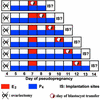Estrogen is a critical determinant that specifies the duration of the window of uterine receptivity for implantation
- PMID: 12601161
- PMCID: PMC151449
- DOI: 10.1073/pnas.0530162100
Estrogen is a critical determinant that specifies the duration of the window of uterine receptivity for implantation
Abstract
Many underlying causes of human infertility have been overcome by using in vitro fertilization (IVF) and embryo transfer (ET) techniques. Nevertheless, implantation rates in IVF programs remain low despite the transfer of apparently healthy embryos. This suggests that there are problems with the differentiation of the uterus to the receptive state in response to the ovarian hormones estrogen and progesterone. The molecular basis of this receptive state when the uterine environment is conducive to blastocyst acceptance and implantation remains poorly understood. Normally, the "window" of uterine receptivity lasts for a limited time. Using ETs and the progesterone-treated delayed-implantation model in mice, we demonstrate here that levels of estrogen within a very narrow range determine the duration of the window of uterine receptivity. Although estrogen at different physiological concentrations can initiate implantation, we find that the window of uterine receptivity remains open for an extended period at lower estrogen levels but rapidly closes at higher levels. The uterine refractoriness that follows the receptive state at high estrogen levels is accompanied by aberrant uterine expression of implantation-related genes. These results suggest that careful regulation of estrogen levels is one of the important factors for improvement of female fertility in IVFET programs.
Figures



References
-
- Psychoyos A. In: Handbook Of Physiology. Greep R O, Astwood E G, Geiger S R, editors. Washington, DC: Am. Physiol. Soc.; 1973. pp. 187–215.
-
- Carson D D, Bagchi I, Dey S K, Enders A C, Fazleabas A T, Lessey B A, Yoshinaga K. Dev Biol. 2000;223:217–237. - PubMed
-
- Paria B C, Reese J, Das S K, Dey S K. Science. 2002;296:2185–2188. - PubMed
-
- Yoshinaga K. Prog Reprod Biol. 1980;7:189–199.
-
- Lim H, Song H, Paria B C, Reese J, Das S K, Dey S K. Vitamins and Hormones. Vol. 64. New York: Academic; 2002. pp. 43–76. - PubMed
Publication types
MeSH terms
Substances
Grants and funding
LinkOut - more resources
Full Text Sources
Other Literature Sources

